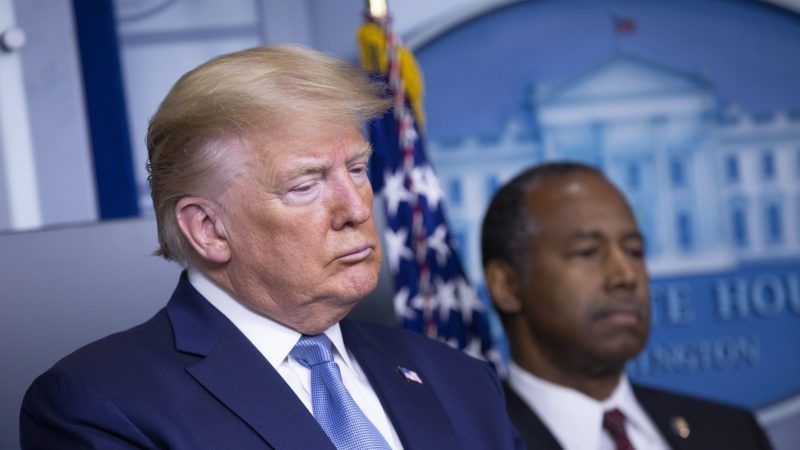Trump Ran as the Nation's NIMBY in Chief. It Didn't Work.
The president promised to save suburbanites' neighborhoods from a wave of new housing development. They voted against him anyway.

President Donald Trump ran a NIMBY-inflected ("not in my backyard") campaign designed to scare suburban voters into supporting him. It doesn't appear to have worked.
"Suburban counties across the country turned away from President Trump in this election," reported The New York Times this morning. "That includes suburbs in the Midwest and the Sun Belt, in inner-ring counties and those farther out, in predominantly white communities and more diverse ones."
Democratic presidential contender Joe Biden improved on Hillary Clinton's 2016 performance in suburban counties by nearly 5 percent on average, and up to 8 percent in suburban, surprisingly swingy Georgia, says the Times.
That matches data parsed by Indeed chief economist and urban demography wonk Jed Kolko, who found that Biden improved Democrats' lead in higher-density suburbs while putting a dent in Trump's lead in lower-density suburban areas, compared to the last presidential election.
The suburbs swung most toward Biden -- by about 5 points.
(Urban counties inched slightly toward Trump, though the urban counties have the least complete data still.)
Update of this: https://t.co/oU0fM3CzvM pic.twitter.com/X4ZvaAsRQx
— Jed Kolko (@JedKolko) November 6, 2020
This result comes in spite of months of repeated warnings from the president that a Biden administration would result in suburbanites' tidy, single-family-zoned communities being overrun by high-density housing, low-income renters, and general urban dysfunction.
"A once-unthinkable agenda, a relentless push for more high-density housing in single-family residential neighborhoods, has become the mainstream goal of the left," wrote Housing and Urban Development (HUD) Secretary Ben Carson in The Wall Street Journal back in August. "We will save our cities, from which these terrible policies have come, and we will save our suburbs."
"Biden will destroy your neighborhood and your American Dream. I will preserve it, and make it even better!" Trump tweeted at the "Suburban Housewives of America" earlier in the summer. Up until the very end of the election cycle, the president was warning rally-goers of the impending destruction of the suburbs and all things holy if Democrats took the White House.
The instrument of suburban America's destruction, according to Trump, was Biden's stated plan to tie federal housing and transportation spending to states and localities adopting reforms to their zoning codes to allow for more, denser housing.
Throughout the campaign, Trump also bragged incessantly about his scrapping of an Obama-era fair housing rule that required recipients of HUD funds to report on obstacles to fair housing and then propose ways of overcoming those obstacles.
Biden has promised to reinstate that regulation, the Affirmatively Furthering Fair Housing (AFFH) rule, which Trump warned would be used to strongarm communities into abolishing their single-family-only zoning laws in order to allow low-income housing developments.
Awkwardly, up until Trump decided to run as the nation's NIMBY in chief, his own administration had been working on an AFFH replacement that was also designed to nudge local communities into repealing red tape on housing development.
Trump's own caustic broadsides against new housing generally ensured his "save the suburbs" message didn't resonate, says Nolan Gray, an urban policy researcher formerly of George Mason University's Mercatus Center.
"NIMBYism is at its most compelling when someone is hearing about a building that's coming in right down the street from them," Gray tells Reason. "I don't think people are moved by the broad general abstract 'more housing is coming' concerns."
That helps explain why in many (but not all) public opinion polls, a majority of voters from both parties express support for new housing in their neighborhoods in the abstract, even as battles over specific projects rage before local zoning boards and city councils.
The obscurity and complexity of the AFFH rule didn't help Trump's marketing either, Gray says: "It's incredibly wonky. It's a legal mandate from a 50-year law that there's already a bipartisan consensus on how to respond to it."
As of Friday morning, votes are still being counted in several swing states. It nevertheless looks like Biden will be the next president, and Republicans will maintain their majority in the U.S. Senate. That, says Gray, could end up being the best result for free market housing policy.
"The things that should concern libertarians the most [about Biden's housing policy] are the big spending bills," he notes. Biden has proposed spending billions more on everything from affordable housing construction to mortgage assistance.
"With divided government, the risk of that is very low, and the chance that there will just be administrative rule changes that are generally going to be positive is high," says Gray.
There is some cause for pessimism on the administrative front, particularly if Biden goes ahead with his stated plan of reinstating the old Obama-era AFFH rule in its entirety. While not the neighborhood-destroying monster that Trump portrayed it as, that rule included burdensome reporting requirements for HUD recipients that consumed a lot of time and money but didn't do a good job of identifying the communities with the most exclusionary housing regulations.
Nevertheless, the failure of Trump's NIMBYism to attract voters is cause for celebration. At a minimum, it's evidence that the electorate is not voting based on which candidate is most wedded to the regulations fueling America's housing affordability crisis.
Rent Free is a weekly newsletter from Christian Britschgi on urbanism and the fight for less regulation, more housing, more property rights, and more freedom in America's cities.



Show Comments (55)